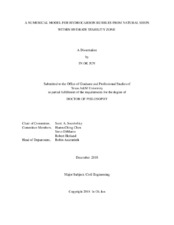A Numerical Model for Hydrocarbon Bubbles from Natural Seeps Within Hydrate Stability Zone
Abstract
Due to the rapid vertical transportation of methane in the ocean, there is a growing concern
regarding the contribution of natural gas seepage to the global atmospheric greenhouse gas budget.
Hence, it is essential to understand the vertical oceanic transport of hydrocarbon gases escaping
from natural seepage. The fate and transport of natural gas in water depend on the rising velocity
and dissolution rates of the bubbles. Especially in the deep ocean, clathrate hydrates of hydrocarbon
gases can be formed and stay stable, and it is unknown how hydrate formation may affect the
fate of hydrocarbons in water. In this dissertation, we develop a numerical model to track the fate
and transport of hydrocarbons released into the deep ocean. The model includes non-ideal equations
of state for complex hydrocarbon mixtures and uses standard empirical correlations for rising
velocity and mass transfer rates for clean and dirty bubbles. For the hydrate effects on bubbles,
we hypothesize that rising velocity and mass transfer rates match those of clean bubbles immediately
after release, and these rates reduce to those of dirty bubbles after a hydrate skin formation
time, which depends on the initial bubble size and the hydrate sub-cooling. After the dissolution,
the transport of dissolved gases in the ocean depends on the combined action of advection and
diffusion. The model simulates the transport of dissolved gases based on the advective-diffusion
equation with the random walk theory, and it can estimate the dissolved hydrocarbon flux through
the water column. The developed model is validated by the observation of hydrate formation on
bubbles from the laboratory and field experiments. The model simulation results are compared
with the measurement of natural seeps, such as the rising height, the trajectory of bubbles, the
spreading of bubble clouds, and the concentration distribution of dissolved methane gas. The developed
model could be used to explain the hydrocarbon gases behavior through the water column
within the hydrate stability zone.
Citation
Jun, In Ok (2018). A Numerical Model for Hydrocarbon Bubbles from Natural Seeps Within Hydrate Stability Zone. Doctoral dissertation, Texas A & M University. Available electronically from https : / /hdl .handle .net /1969 .1 /174345.


